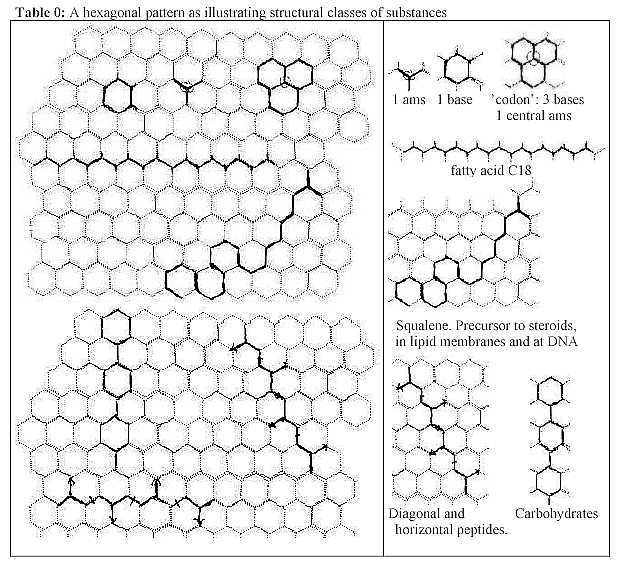A main question:
Why genes, why this coding system between RNA and proteins?
It's suggested here that the relation between codon triplets of
bases and amino acids could be illustrated (note just illustrated)
as in the table 0 below. Other classes of substances are marked
as well in the pattern, i. e.. their main structural properties,
showing on their close relationships.

The hexagonal pattern - as in graphite - can be regarded either
as a pattern of hexagons, sharing edges with one another - or as
consisting of atomic points, centers with 3 radii.
Virtual 4th valence pointing upwards from the
plane, as towards next layer in a crashed or sliced diamond.
In this illustration the relation bases - amino acids shows
up to be only a question of complementary "aspects", a
fundamental one on the whole pattern.
One property of these aspects is the polarity
between circular and radial structures. Another is the center -
anticenter polarity with regard to the carbon atoms: in amino acids
a central C-atom of tetrahedrons, in hexagon rings decentralized,
anti-centric atoms.
A third, also fundamental, aspect is the physical polarity between
mass (atomic structure) versus space as antimatter, which may appear
when regarding the whole pattern as structures of fatty acids.
It means "semipermeable" membranes, another essential
condition for life. At a certain temperature they also form hexagonal
patterns (Lindahl et al 1967).
The mentioned polarities correspond to the complementary "poles"
or "partial structures" in the proposed, dimensional
background model here and follows from polarizations of
dimension degrees 5 - 4 - 3.
Codon bases - amino acids:
Each "3-radii-center" gets defined by 3 hexagons - as
do amino acids through a codon triplet.
Each coding base gets synthesized to an essential
degree of amino acids, the simplest one, Gly, being a kind of displaced
center, an intermediate bridge between the two rings in purine bases
G and A from Hypoxanthine). The amino acid Asp gives about
half the rings of pyrimidine bases U and C.
(A hexagon ring of the bases include 4 C, 2 N,
corresponding to 2 N-C-C-parts in bound backbone chains of amino
acids.)
How could anything that only would be two different aspects, get
translated to existing processes in a cell?
If departing from the illustration in the figure
above, it seems necessary to imagine that the two opposite "aspects"
on such a pattern - in some way* - get polarized into separate types
of units, substantiated and saturated to structural classes of molecules
in interaction with present substituents as N, O, H (nitrogen, oxygen
and hydrogen). Further that the long range of intricate processes
develops "the other way around" to recombine to the sense
of a "reference system". This within - or on? - demarcating
layers of fatty acids.
* The idea of a crashed diamond leads to the thought of different
substances created from the different pathways and diffraction
of light in the crystal.
Resevations:
The figure doesn't include pentagon rings, e.g. the extra three
edges in purine bases or ribose molecules, not differences in angles
of valences etc. With the figure above it's not the intention to
assert that this was 'the way it happened'.
Yet, it may illustrate the close relations between
substances and the underlying two aspects on the whole structure:
a pattern of rings or a pattern of centers with 3 radii - and a
virtual 4th for differentiated growth of side chains (R) of ams?
